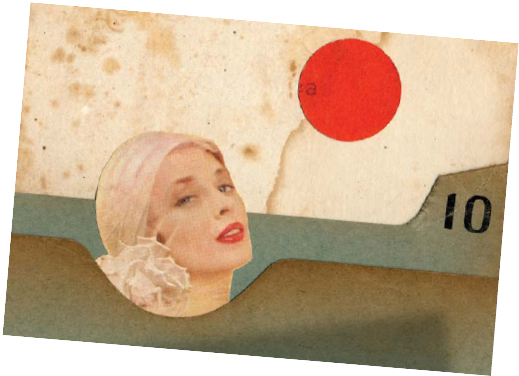
David Wallace
Starting a collage is always daunting to me. When I enter my studio (my one-car garage) and look at the empty worktable, I’m often filled with dread.
I fear not being able to come up with anything. Some days that is the case, but on other days, I can make four or five pieces in one creative spurt.
Most of my work begins with the materials. I never set out to make a piece “about” anything, although sometimes it becomes “about” something as I go along. I’m inspired by the effects of nature and time, and I love finding examples of what I call “accidental” art—peeling paint, rusting metal, stained paper and fading photographs. My materials tend to have a layer of grit or a little dirt, and they all have a mysterious and unknown history. This aesthetic is similar to the Japanese concept wabisabi, which states that nothing lasts, nothing is finished and nothing is perfect. The imperfections in something add to its appeal and charm and give it character.

DEEP END
Every piece of paper I see is a potential piece of a future collage. When I first started making collage, I imagined I was saving the material from some kind of image landfill. As an avid gardener and environmentalist, I am aware of the amount of waste in the world, so I enjoy taking old, beat-up and forgotten images and remaking them into something I hope is artful.

THAT VERY THING
I start with the backdrop, which could be anything from a page torn out of an old dictionary to a piece of wallpaper. Because I tend to think of my collages as portraits, I next look for a central figure—a point of focus for the piece. From there, the work proceeds as trial and error, with me moving pieces of paper on and off the background until something resonates. A story begins to be told—a loose but probably obscure narrative begins to form, and the collage begins to take shape.
For example, in the piece titled Deep End, the color and shape of the record sleeve looked like water to me. The numbered sleeve reminded me of a marker indicating the water’s depth. The stained paper looked like a cloudy sky, and the tilt of the woman’s head in this environment could look like she was straining to stay above the waves. It’s all about context and proximity. The image of the woman’s head was actually cut from an old panty-hose ad, and her head tilt probably signaled her extreme joy at wearing such a fine product.
So this piece tells a story, at least in my mind. You may have a completely different interpretation. But a story is not the only thing that gives a piece direction. Other times, there is no narrative. Sometimes everything just fits together, and it feels right.
This juxtaposition of seemingly unrelated photos, textures and words into a unified whole is what keeps me coming back to collage. I never get bored with it. I don’t remember exactly why I started making collages, but it is something I believe I’ll always do as long as I make art.

